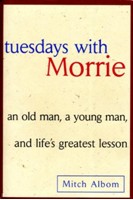"Once you learn how to die, you learn how to live." A single quote from the book, tuesdays with Morrie. Of all the phrases Morrie uses in the book, this one was the most deep and emotional. This quote was the ultimate lesson from Morrie, a concise but meaningful summary of Mitch and his Final Thesis: the two's last project. Every aspect of the book, whether it was about love or forgiveness, ultimately came back to this single quote.
 |
tuesdays with Morrie by Mitch Albom |
At first glance, the quote seems to be paradoxical. How could a human learn how to live after learning how to NOT live; to face death? If a human is dying, is not he/she at the end of his/her life? This was my reaction when I first came across the quote. The quote is written slightly before the half-way point of the book. Hence, it was difficult to comprehend what Morrie was trying to say at first. It seemed to be one of those rhetoric dilemmas that often come up in books that deal with famous quotes. But, to my satisfaction, this quote was not one of those. As I read on, I started to understand what Morrie was trying to say. As his health deteriorated and he got closer to death, he became more dependent on others. By depending on others to do the things he used to be able to do, Morrie himself learned how important other people, especially his family, were to him. He learned the significance of relationships in his life and to treasure them even after his death. Morrie's quote for this is,
"Death ends a life, not a relationship." (page 174)
On their fourth Tuesday together, Mitch and Morrie talk about death. Morrie says that although everyone is aware that they will eventually die, no one is ready to believe it or accept their ultimate fate. To Mitch's surprise, Morrie goes on to say that he is grateful that he knows death is coming. He states that he is happy to have time to say his farewells and to think about the things he would not think about otherwise. He tells Mitch that only when a person realizes how close death is to them, the person will realize the true importance of life and pursue it. Only after accepting death will the person be able to discard his or her greed for power and fame, to pursue what is truly meaningful to them; love and affection. Morrie says that nowadays people have an excessive desire for things from the materialistic world, things that will eventually rot away, and not enough desire for the emotions that will persist even after death. There are quite a few quotes that deal with this issue, such as:
"If you accept that you are going to die anytime, then you might not be as ambitious as you are." (page 83)
"Don't cling to things, because everything is impermanent." (page 103)
"Money is not a substitute for tenderness, and power is not a substitute for tenderness." (page 125)
Just as Morrie said in his quotes, we can understand that to him, death has brought more than it will ever be able to take. The realization of death is what will open our eyes to truly live in a meaningful way.
After finishing the book, I went back to page 82 to reread the quote that had been at the back of my mind throughout the whole novel. The page, letters, font, everything was the same as the first time. But the meaning of that single phrase was completely different. I now understood what Morrie was trying to say, what the words had truly meant. Life and death are like light and darkness; we appreciate light because we know what darkness is. An eternal life would be a waste of time, as we would take life for granted and not appreciate it. Death is why we should be grateful for our lives and to live them to the fullest. As I wrote in my introduction, every aspect of the book connects to the single quote,
"Once you learn how to die, you learn how to live."
Child Research Net would like to thank the Doshisha International Junior/Senior High School and Soichiro Hattori, student and author, for permitting reproduction of this article on the CRN web site.














